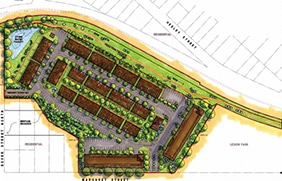LEED Spotlight: Preston Meadows in Cambridge, ON, becomes the first fully certified LEED ND Pilot in Canada
Cambridge, Ontario
November 20, 2015
- Rating System/Standard
- LEED v1
- Certification Level
- Certified
- Building Type
- Mixed-use
Located at 633 Margaret St. Cambridge, ON, Preston Meadows had historically been used for industrial purposes dating back to 1908, including the manufacturing of rail cars. From 1924 to 1991, the site was operated as a foundry. Eighty years later, Reid’s Heritage Homes purchased 10 acres of the land with an ambitious plan to make it a sustainable community. But before the site could be given a new life, it had to be fully remediated and all sources of contamination removed.
We spoke with Jim Dodd of Reid Heritage Homes and Derek Satnik of Mindscape Innovations about this unique project, and how it was ultimately achieved.
Project Team
- Project Owner/Developer
- Reid’s Heritage Homes Ltd.
- Architect
- BJC Architects
- LEED Consultant
- Mindscape Innovations Inc.
- Landscape Architect (if applicable)
- Stantec Consulting
- Commissioning Authority
- RHC Design Build and Reid’s Heritage Homes Ltd.
A remediated brownfield site that turned hazard into healthful

Project efforts for Preston Meadows began in 2005, where Reid’s Heritage Homes purchased 10 acres of land in Preston (Cambridge), Ontario and then invested three years working with the City of Cambridge and Region of Waterloo to clean the former brownfield site. There were various sources of contamination in the soil including spills from use and storage of chemicals.
The site is now home to 82 townhomes and two apartment buildings, including 107 units of affordable rental and for-sale housing.
Many of the features for this LEED-ND Certified Pilot project focused on site design that lends itself to a healthier, integrated, more accessible and affordable community for residents with local landscape features and amenities. This includes:
- Better designed site: protecting sensitive local waterways and wildlife, protecting the floodplain, avoiding farmland (e.g.: by reusing an industrial brownfield).
- Better connected neighbourhood: starting with a smart location, minimizing the impact on existing infrastructure like water and sewer, connecting well with the surrounding neighbourhood, striving for increased density, but in an open and connected way.
- Better coordinated buildings: having a good mix of housing sizes and types, including affordable housing, taking extra care to manage construction pollution (e.g.: dust), building highly efficient buildings, reducing water use, and using recycled content for buildings and infrastructure (e.g.: in the roads and sidewalks.
Project helped U.S. and Canada refine LEED for Neighbourhood Development program

Reid’s Heritage Homes worked with the US and Canada Green Building Council’s for eight years and helped to refine and launch their LEED for Neighbourhood Development program. Efforts began to define a version of LEED for Homes in 2004, and shortly thereafter for LEED-ND. The Canadian Pilot program was launched in 2008-2009. The LEED-ND program entered the pilot the same year and Preston Meadows was one of the first Canadian projects to apply. Reid’s has a history of green firsts in Canada, and is proud to be continuing their tradition of leadership.
As a builder, Reid’s follows all industry best practices in every community they design, and the Preston Meadows site presented some unique challenges and opportunities that seemed like an ideal case to measure with the LEED-ND rating system: to measure themselves against industry best-practice for green construction at the neighbourhood development level.
For Reid’s, this project was on a growing list of environmental achievements. They continue to embark on this journey of “firsts” and consistently strive to raise the mark for sustainability. The company is currently nearing completion of five Net Zero Homes in Guelph, as one of only five specially chosen builders across Canada to participate in the ecoENERGY Efficiency Initiative in partnership with Natural Resources Canada and Owens Corning Canada.
Health at the heart of this sustainable neighbourhood
Many reports have now demonstrated and re-demonstrated that the average North American spends some 90% of their time indoors, and that this can lead to a host of health challenges. Better designed communities encourage people to get outside and walk more, or to simply enjoy the outdoors more. Preston Meadows takes LEED to the neighbourhood level, and spent considerable effort looking at local amenities and community features that would draw residents out to walk more. Direct sidewalk and trail connections are at the doorstep for every unit making walking to the park, to work, to school or with a pet easier and more accessible in an environment that is removed from vehicular traffic and in park-like settings.
This includes reduced automobile dependence: at least 62 transit rides are available per weekday within a quarter mile (0.4 km) walking distance of 76% of the homes. This credit was implemented to encourage the use of public transportation and reducing personal motor vehicle use. They also focused on access to active spaces: 100% of dwellings are within 0.4 km walking distance to a multi-acre active open facility, encouraging walking, physical activity and time spent outdoors.
